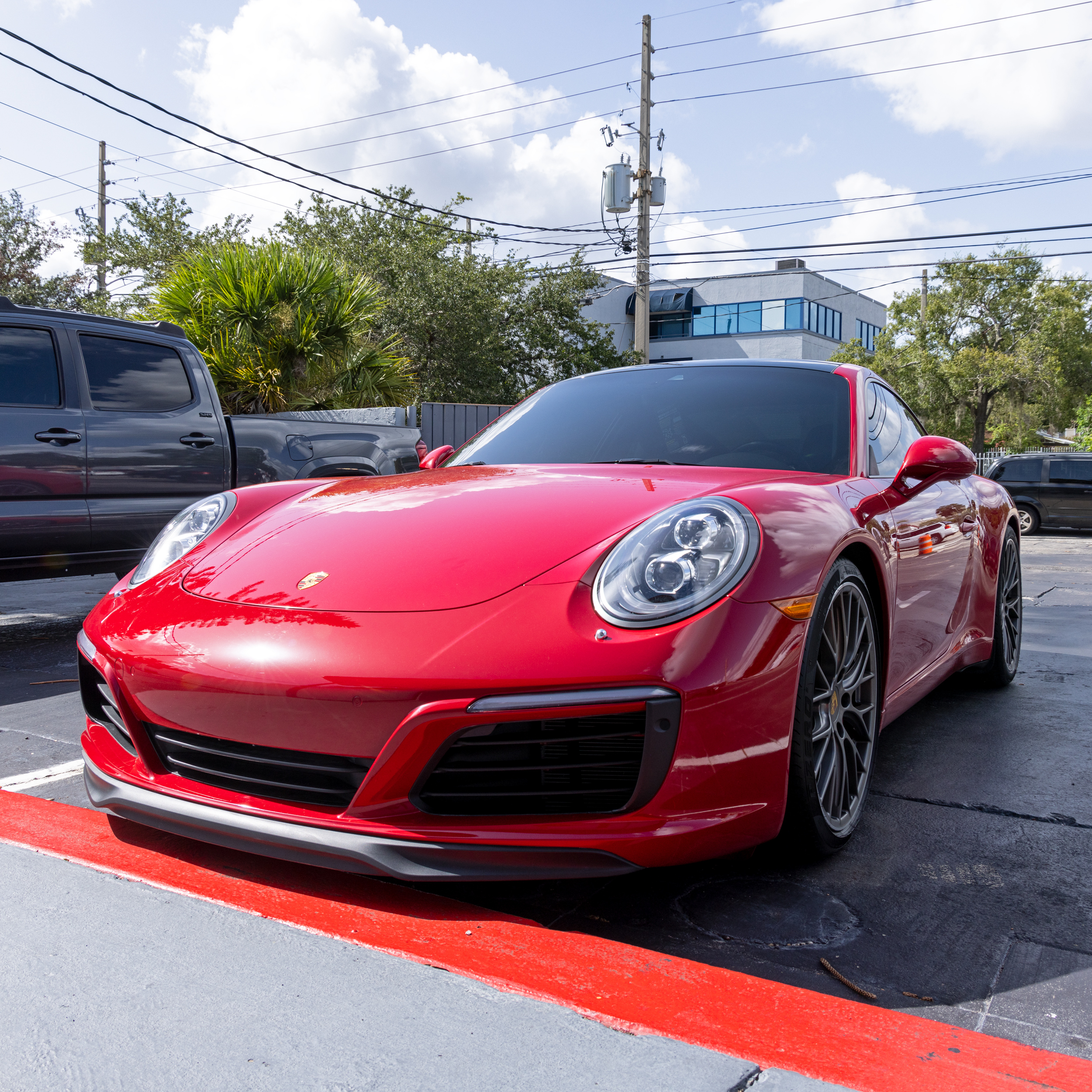
Window tinting has come a long way since its introduction to the automotive and flat glass (commercial & residential) markets decades ago. 3M Corporation, a leader in the window tinting industry, released their first sun control window film in 1966, over 56 years ago. Once a simple choice between a darker or lighter shade, modern window films offer a dizzying array of choices with varying benefits and trade-offs.
Among this vast landscape of options, two types of car window tint stand out – ceramic tint and regular tint (dyed / nano-carbon). However, with these options comes the confusion of what to choose. Should one go for the regular dyed film because of its affordability, or opt for the high-tech ceramic tint for its superior features?
There’s also 3M Crystalline, which is technically neither a dyed or ceramic film but has superior heat rejection qualities at lighter tint shades than either of these options. Read this article to learn about the differences between 3M Crystalline & Ceramic window films like 3M Ceramic IR.
A Close Look at Regular Car Window Tint
Commonly known as dyed film, ‘regular’ tint has been the go-to choice for vehicle owners for years. As a cost-effective option, it provides a decent level of privacy and reduces some of the sun’s glare. Regular window tint works by absorbing some of the solar heat and UV rays, offering a degree of heat reduction and UV protection. It’s a budget-friendly choice for vehicle owners who want to add a touch of privacy and sophistication to their ride.
Also, through the years, manufacturers like 3M have made improvements upon their dyed films, improving overall durability as well adding resistance to discoloration and purpling that’s backed up by their limited lifetime warranty offered to all customers that select an Authorized 3M Window Film Dealer like Pro Tint of Florida for installation. 3M Obsidian rejects up to 99% of UV rays, and up to 93% of the sun’s glare – significantly more than other dyed films in its class.
However, despite its affordability and the aesthetic upgrade it provides, standard tint comes with a few downsides. The infrared heat rejection capabilities of regular window tint aren’t as strong compared to more advanced tinting options, such as ceramic tint. While it offers some degree of heat reduction, and increasingly more UV protection, it’s not the best choice for those primarily looking to keep their vehicles cool in the sun.
Cheap tint, as some might call it, also doesn’t provide a high level of infrared protection. Infrared radiation is what mostly makes sunlight feel hot. So, without a strong defense against it, even a darker tint shade may not significantly cool down a car with cheap DIY window film on it.
Despite having some weaknesses in terms of infrared rejection, regular window tint, especially advanced dyed films like 3M Obsidian, remain a viable option for car owners who are on a budget and are satisfied with a moderate amount of heat reduction, reduced glare and added privacy.
Ceramic Window Films: A Metal-Free, Modern Tinting Solution
Stepping into the realm of cutting-edge technology, ceramic window films like 3M Ceramic IR have significantly elevated the benefits of window tinting for today’s car owners. With nano-ceramic technology at its core, ceramic window tinting offers a plethora of benefits that far exceed those of standard tint.
Unlike regular tint that uses dyes, ceramic window tint involves the infusion of ceramic particles into the film. These nano-ceramic particles play a crucial role in blocking out harmful UV rays and rejecting a much greater amount of solar heat. This results in excellent UV protection and heat reduction, keeping vehicles cool and comfortable even on the hottest summer days in Florida.
One of the most appreciated features of ceramic window tint is its impressive infrared rejection capabilities. Infrared light is the primary culprit behind the heat we feel from the sun. 3M Ceramic IR can reject up to 95% of solar infrared rays, making each drive feel significantly cooler.
In terms of color stability, ceramic window tint takes the lead. It’s highly resistant to fading, ensuring that post-installation, the window film maintains its rich color for years to come. The structural stability of ceramic tint also prevents bubbling and peeling, common issues faced by cheaper films.
Ceramic window film does more than just keep cars cool. Its high-tech construction ensures minimal signal interference, which means electronic devices will work just as efficiently with the tint on. This is an issue that metallized window films, which are being gradually phased out and replaced by nano-carbon films like 3M Color Stable, had largely suffered from.
Moreover, ceramic window tint offers superior clarity, ensuring that the driver’s view isn’t compromised while still reducing glare from the sun. It’s an excellent choice for those looking to achieve a balance between privacy, comfort, and visibility.
To sum up, ceramic tint, with its advanced technology and comprehensive benefits, presents a compelling option for car owners seeking high performance and lasting durability. However, it’s also worth noting that all of these premium features come at a relatively higher price point compared to regular tint.
Ceramic Tint vs Regular Tint – In Summary
Choosing between ceramic and regular window tint isn’t a decision to be made lightly – it can significantly impact the driving experience, the lifespan of a vehicle’s interior, and even the look and feel of the car. Let’s stack up these two contenders side-by-side to help readers make an informed decision.
First, when it comes to infrared heat rejection and color stability, ceramic tint comes out on top. Its advanced construction helps to block nearly 99% of harmful UV rays and reject a significant amount of solar heat, making each ride cooler while also adding UV protection to the car’s interior for protection from sun damage. Due to the addition of ceramic particles in the film, as opposed to dyes, ceramic window films are not prone to the purpling and fading over time like many dyed films are. Regular tint, on the other hand, with advanced films like 3M Obsidian now offering up to 99% UV protection as well as a moderate amount of heat reduction, won’t quite measure up to the overall performance of ceramic tint.
Second, the level of infrared protection offered by these two types of window films are starkly different. Regular tint does not have much infrared rejection qualities, while ceramic window films like 3M Ceramic IR are able to block up to 95% of infrared rays, contributing further to the heat reduction inside of a tinted vehicle.
The difference in visual appeal and privacy between these two is also worth noting. Both types of tints come in a range of shades, allowing drivers to choose the visible light transmission (VLT) level that suits their aesthetic preference and need for privacy. However, ceramic films provide better clarity, making the driver’s view from inside the car clearer while reducing the sun’s glare as effectively, if not more, than modern dyed films like 3M Obsidian.
In terms of lifespan and durability, ceramic tint is far superior. While it might come at a higher price point, the durability and superior performance of ceramic tint can save drivers from frequent replacements, offering better value in the long run.
As for the legal aspect, all window tints must comply with the state laws governing window tint darkness and reflection. It’s crucial for drivers to check the specific regulations in their state before making their decision, as extremely restrictive states like California (requiring all automotive window tints to be 70% or greater VLT) may encourage drivers to spend more for a film like 3M Crystalline for its superior heat rejection properties at even the lightest tint shades. Drivers in Florida can check this article to learn more about Florida’s window tinting laws.
While it might seem like ceramic tint is the clear winner, the choice between ceramic tint and regular tint ultimately comes down to personal preference, the driver’s specific needs, and of course, budget. Dyed films like 3M Obsidian remain an excellent choice for those looking for a cost-effective solution, while ceramic films like 3M Ceramic IR are ideal for those seeking the most advanced features and long-lasting performance. Nano-carbon films like 3M Color Stable fall in-between these two, and offer a balance between both worlds.

